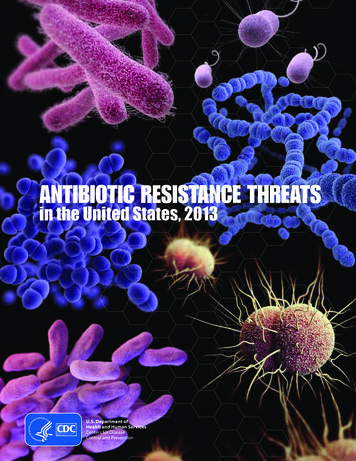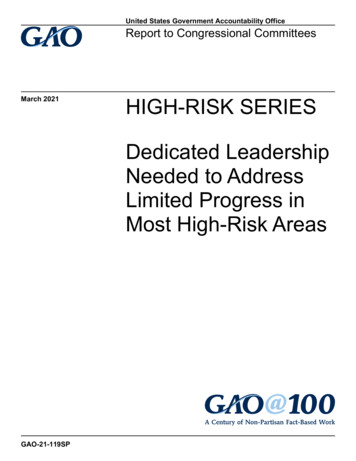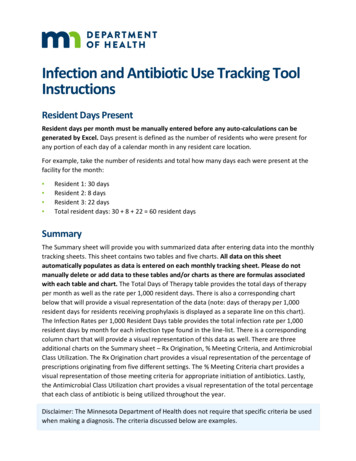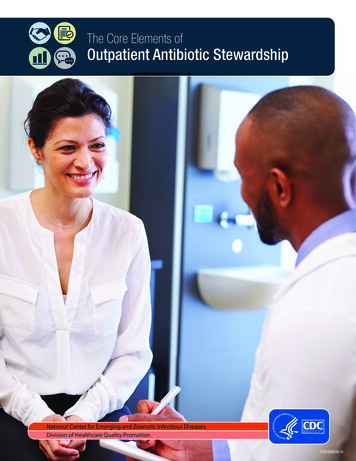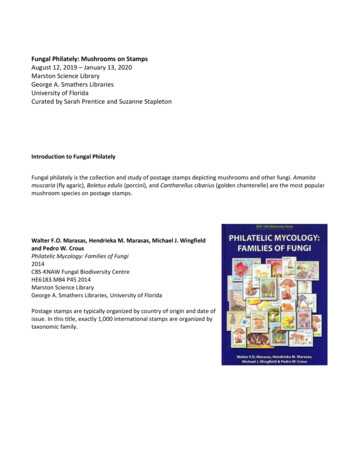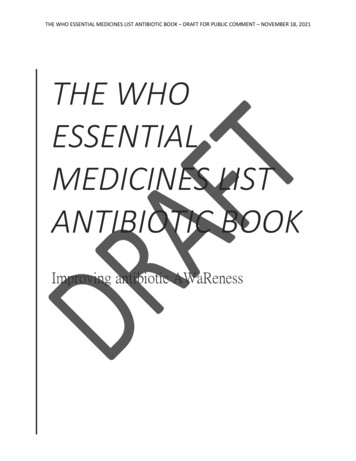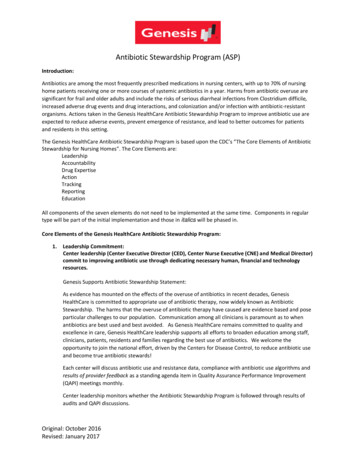
Transcription
United States Government Accountability OfficeReport to Congressional RequestersMarch 2020ANTIBIOTICRESISTANCEAdditional FederalActions Needed toBetter DetermineMagnitude andReduce ImpactGAO-20-341
March 2020ANTIBIOTIC RESISTANCEHighlights of GAO-20-341, a report tocongressional requestersAdditional Federal Actions Needed to BetterDetermine Magnitude and Reduce ImpactWhy GAO Did This StudyWhat GAO FoundBacterial infections have becomemore difficult, and sometimesimpossible, to treat due to antibioticresistance, which occurs whenbacteria develop the ability to defeatthe available drugs designed to killthem. Concerns about rising rates ofresistance to available treatmentoptions prompted the federalgovernment to create the 5-yearNational Action Plan in 2015. Theplan called for federal agencies tostrengthen surveillance, advance thedevelopment of diagnostic tests andnew antibiotics, and slow theemergence of resistant bacteria,among other things.The precise magnitude of the problem of antibiotic resistance is unknown. TheCenters for Disease Control and Prevention (CDC) has made progress inexpanding surveillance of infections from certain antibiotic-resistant bacteria inthe United States and abroad but faces several challenges.GAO was asked to review federalefforts to address antibioticresistance. This report examinesfederal efforts and challengesrelated to (1) surveillance ofantibiotic resistance, (2) thedevelopment and use of diagnostictesting to identify antibioticresistance, (3) the development oftreatments for resistant infections,and (4) appropriate antibiotic use.GAO reviewed literature and agencydocuments; interviewed agencyofficials and health care industry,drug industry, and otherstakeholders; and held a meeting ofinternational and U.S. experts toobtain their views.What GAO RecommendsGAO is making eightrecommendations to strengthen thefederal response to combatingantibiotic resistance. HHS concurredwith seven recommendations anddid not concur with one. More detailsare provided on the next page.View GAO-20-341. For more information,contact Timothy M. Persons at (202) 512-6888or personst@gao.gov, or Mary DeniganMacauley at (202) 512-7114 ordeniganmacauleym@gao.gov.2001-2017 Cumulative Spread of One Type of Highly Resistant Bacteria in the United StatesNote: This figure tracks a type of carbapenem-resistant Enterobacteriaceae (CRE), which, according to CDC, is a“nightmare bacteria” resistant to nearly all available antibiotics. Shading indicates CDC confirmed the presence ofthese bacteria within that state in that year or a previous one.CDC faces challenges in conducting surveillance for antibiotic resistance due tothe limited data it is able to collect through various surveillance systems. Forexample, CDC’s primary surveillance system for gonorrhea—which CDCclassified as an urgent antibiotic resistance threat affecting over half a millionpatients annually—currently tracks only an estimated 1 to 2 percent of all U.S.cases and only in males. CDC has not fully evaluated the representativeness ofthe gonorrhea surveillance system’s results. However, it could do so, forexample, by comparing the trends in their limited sample population with trends itcan establish in the overall U.S. population via additional studies. Such anevaluation could give CDC more confidence that the system’s data accuratelyreflect national trends.Federal agencies have taken steps to advance the development and use ofdiagnostic tests to identify antibiotic-resistant bacterial infections, but theseefforts have limitations. For example, agencies have conducted some studies toestablish whether testing can lead to positive health care outcomes, such asreduced rates of antibiotic-resistant infections. However, more such studies areneeded, according to experts and agency officials. Without information to guidetest usage, clinicians may not be able to select appropriate treatments for theirpatients. One reason for the insufficient number of studies is that Department ofUnited States Government Accountability Office
What GAO RecommendsIn response to the findings presentedin this Highlights, GAO recommendsthat: CDC ensure that its evaluation ofits surveillance system forantibiotic-resistant gonorrheaincludes measures of thesystem’s representativeness ofthe U.S. population;HHS identify leadership andclarify roles and responsibilities toassess the clinical outcomes ofdiagnostic testing;HHS develop a strategy to furtherincentivize the development ofnew treatments for antibioticresistant infections, includingthrough the use of postmarketfinancial incentives;HHS direct the CARB Task Forceto include in its annual updates tothe President plans foraddressing any barrierspreventing full implementation ofthe National Action Plan.Health and Human Services (HHS) agencies that are in a position to conduct orfund such studies—such as CDC and the Biomedical Advanced Research andDevelopment Authority—disagree about what each agency should do. Byclarifying roles and responsibilities, HHS agencies could more effectively addressthe need for more studies. The resulting studies could help demonstrate thevalue of diagnostic tests for antibiotic resistance, potentially increasing their useand improving patient care.Experts warn that the current pipeline of antibiotics in development is insufficientto meet the threat of resistance. Several challenges impede the development ofnew treatments for resistant infections, notably inadequate return on investmentfor drug companies largely due to low prices and a limited patient population forwhom these treatments would be appropriate. While HHS and Department ofDefense agencies have provided financial premarket incentives to supportantibiotic research and development, experts, federal officials and antibioticdevelopers agree that more postmarket incentives are needed to overcome theeconomic challenges. Advisory groups, including a presidential advisory council,and others have called for new postmarket incentives and identified multipleoptions for their design, including market entry rewards and reimbursementreform (see figure). However, HHS has not developed a strategy to furtherincentivize development of new treatments for antibiotic-resistant infections, andit may need to request authority and appropriations to create and implementcertain types of incentives. Until such incentives are developed, more drugcompanies may exit the antibiotic development sector, and the pipeline of newtreatments may continue to decrease.Examples of Possible Postmarket Incentive Options to Encourage the Development ofAntibiotics Identified by Advisory Groups and OthersIn addition, GAO is making fourrecommendations to address otherCDC efforts in surveillance andreporting and to address FDA effortsin monitoring diagnostic tests.HHS did not concur with therecommendation that it develop astrategy that includes the use ofpostmarket financial incentives toencourage the development of newtreatments for antibiotic-resistantinfections, citing its ongoing analysisto understand whether postmarketincentives should be included in sucha strategy. GAO recognizes thecomplexity of this issue and maintainsthat this recommendation is warrantedgiven that experts and others havecalled for additional postmarketincentives and the insufficiency of thecurrent pipeline of new treatments forantibiotic-resistant infections.Federal agencies have made several efforts to promote the appropriate use ofantibiotics across health care settings through antibiotic stewardship—givingpatients the right antibiotic at the right time, in the right dose, and for the rightduration. However, key challenges remain. For example, federal agenciesrequire only certain types of health care facilities to implement stewardshipprograms. In addition, CDC is limited in its ability to monitor and improveappropriate antibiotic use, in part because providers are not generally required toreport antibiotic use data to a centralized database. The 5-year National ActionPlan for Combating Antibiotic-Resistant Bacteria (National Action Plan) calls forstrengthening antibiotic stewardship and for the timely reporting of antibiotic usedata across health care settings. An executive order directs an interagency taskforce—the Combating Antibiotic-Resistant Bacteria (CARB) Task Force,coordinated by HHS—to provide annual updates to the President on, amongother things, plans for addressing any barriers to full implementation of theNational Action Plan. However, in its progress reports covering the first 4 years ofthe National Action Plan’s implementation, the task force did not identify plans toaddress barriers to expanding antibiotic stewardship programs or the collection ofantibiotic use data. Until it does so, the government will not have reasonableassurance that it is fully implementing the National Action Plan and addressingantibiotic resistance.United States Government Accountability Office
ContentsLetter1BackgroundCDC Has Expanded Surveillance of Antibiotic Resistance, butFaces Challenges Determining the Magnitude of the ProblemFederal Agencies Have Helped Advance Diagnostic Tests andPromoted Their Use, but These Efforts Have LimitationsFederal Efforts Have Not Fully Addressed Challenges toDeveloping New Treatments for Antibiotic-Resistant InfectionsFederal Agencies Have Undertaken Several Efforts to Promotethe Appropriate Use of Antibiotics, but Key Challenges RemainConclusionsRecommendations for Executive ActionAgency Comments and Our Evaluation817355374929495Appendix IObjectives, Scope, and MethodologyAppendix IIExpert Meeting Participant List107Appendix IIIAdditional Examples of Federal Efforts to Support AntibioticResearch and Development110Additional Information on Federal Efforts to Promote AppropriateAntibiotic Use113Appendix VComments from the Department of Health and Human Services119Appendix VIGAO Contacts and Staff Acknowledgments128Appendix IVPage i99GAO-20-341 Federal Efforts to Address Antibiotic Resistance
TablesTable 1: Examples of Key Roles and Responsibilities of SelectDepartment of Health and Human Services AgenciesRelated to Combating Antibiotic ResistanceTable 2: Description of Centers for Disease Control andPrevention (CDC) Surveillance Systems and PriorityBacteria TrackedTable 3: Examples of Federal Agencies’ Funding of Research andDevelopment for New Treatments for Antibiotic-ResistantInfectionsTable 4: Examples of Factors That Drive or Deter AntibioticPrescribing BehaviorTable 5: Additional Examples of Federal Efforts to SupportAntibiotic Research and DevelopmentTable 6: Examples of Federal Efforts to Promote the AppropriateUse of Antibiotics15176191110113FiguresFigure 1: Bacteria CDC Considered to Be Threats in 2013 and2019Figure 2: Resistant Gonorrhea Sentinel Surveillance Sites andRegional Testing Laboratories, 2018Figure 3: Examples of Currently Available Federal Incentives forAntibiotic DevelopmentFigure 4: Examples of Possible Postmarket Incentive Options toEncourage the Development of Antibiotics Identified byAdvisory Groups and OthersFigure 5: Percentage of U.S. Hospitals Reporting Antibiotic UseData to CDC’s National Healthcare Safety Network, byState, as of August 2019926677086AbbreviationsAHRQAR OptionAU OptionPage iiAgency for Healthcare Research and QualityAntimicrobial Resistance OptionAntimicrobial Use OptionGAO-20-341 Federal Efforts to Address Antibiotic Resistance
AUR Module Antimicrobial Use and Resistance ModuleBARDABiomedical Advanced Research and DevelopmentAuthorityCARBCombating Antibiotic-Resistant BacteriaCARB-XCombating Antibiotic-Resistant BacteriaBiopharmaceutical AcceleratorCDCCenters for Disease Control and PreventionCLSIClinical and Laboratory Standards InstituteCMSCenters for Medicare & Medicaid ServicesDODDepartment of DefenseeGISPEnhanced Gonococcal Isolate Surveillance ProjectEIPEmerging Infections ProgramFDAFood and Drug AdministrationGISPGonococcal Isolate Surveillance ProgramGLASSGlobal Antimicrobial Resistance Surveillance SystemGPRAGovernment Performance and Results ActHHSDepartment of Health and Human ServicesLPADLimited Population Pathway for Antibacterial andAntifungal DrugsMIPSMerit-based Incentive Payment SystemMRSAMethicillin-resistant Staphylococcus aureusNARMSNational Antimicrobial Resistance Monitoring SystemNHSNNational Healthcare Safety NetworkNIAIDNational Institute of Allergy and Infectious DiseasesNIHNational Institutes of HealthPACCARBPresidential Advisory Council on Combating AntibioticResistant BacteriaQIDPQualified Infectious Disease ProductR&Dresearch and developmentSURRGStrengthening the United States Response to ResistantGonorrheaTATFARTransatlantic Taskforce on Antimicrobial ResistanceVADepartment of Veterans AffairsWHOWorld Health OrganizationThis is a work of the U.S. government and is not subject to copyright protection in theUnited States. The published product may be reproduced and distributed in its entiretywithout further permission from GAO. However, because this work may containcopyrighted images or other material, permission from the copyright holder may benecessary if you wish to reproduce this material separately.Page iiiGAO-20-341 Federal Efforts to Address Antibiotic Resistance
Letter441 G St. N.W.Washington, DC 20548March 30, 2020The Honorable Lamar AlexanderChairmanThe Honorable Patty MurrayRanking MemberCommittee on Health, Education, Labor, and PensionsUnited States SenateThe Honorable Frank Pallone, Jr.ChairmanThe Honorable Greg WaldenRepublican LeaderCommittee on Energy and CommerceHouse of RepresentativesThe Honorable Diana DeGetteChairThe Honorable Brett GuthrieRepublican LeaderSubcommittee on Oversight and InvestigationsCommittee on Energy and CommerceHouse of RepresentativesSince the discovery of penicillin in 1928, many life-saving antibiotics havebeen developed that have allowed previously incurable infections to beeasily treated. However, many types of infections have become moredifficult or impossible to treat as bacteria have developed resistance tomost—or, in some cases, all—currently available antibiotics. The Centersfor Disease Control and Prevention (CDC) considers antibiotic resistancePage 1GAO-20-341 Federal Efforts to Address Antibiotic Resistance
to be one of the greatest global public health threats of our time. 1 In 2019,CDC estimated that at least 2.8 million people get sick and at least35,900 die each year from antibiotic-resistant infections in the UnitedStates. 2While bacteria naturally develop resistance to antibiotics over time, thisproblem has been accelerated by the overuse and misuse of antibiotics in1Antimicrobialresistance refers broadly to drug-resistant bacterial, fungal, viral, and othertypes of microbial infections. For the purpose of this report, we focused on antibioticresistance. CDC uses the term “antibiotics” to refer to drugs that can kill bacteria or fungi.See Department of Health and Human Services, Centers for Disease Control andPrevention, Antibiotic Resistance Threats in the United States, 2019 (Atlanta, Ga.: Nov.13, 2019), p. 7. Our review focused on resistance of bacteria against antibiotic drugs anddid not focus on resistance of fungi against drugs. In contrast, under the Food, Drug andCosmetic Act, the term “antibiotic drug” means “any drug (except drugs for use in animalsother than humans) composed wholly or partly of any kind of penicillin, streptomycin,chlortetracycline, chloramphenicol, bacitracin, or any other drug intended for human usecontaining any quantity of any chemical substance which is produced by a microorganismand which has the capacity to inhibit or destroy microorganisms in dilute solution(including a chemically synthesized equivalent of any such substance) or any derivativethereof.” 42 U.S.C. § 321(jj). Note that under the definition under the 21st Century CuresAct, which amended Section 319E of the Public Health Service Act, that for certainpurposes of the law, the term “antimicrobial” includes “any antibacterial or antifungaldrugs, and may include drugs that eliminate or inhibit the growth of other microorganisms,as appropriate.” 42 U.S.C. § 247d-5(k).2Centersfor Disease Control and Prevention, Antibiotic Resistance Threats, 2019. In2013, CDC had estimated at least 2 million people got sick and 23,000 people died eachyear from antibiotic-resistant infections; however, in its 2019 report, CDC revised its 2013estimates by using new data sources and stated that the annual number of antibioticresistant infections in 2013 was at least 2.6 million, with 44,000 deaths. See Departmentof Health and Human Services, Centers for Disease Control and Prevention, AntibioticResistance Threats in the United States, 2013 (Atlanta, Ga.: Apr. 23, 2013).A study funded by the European Centre for Disease Prevention and Control estimated671,689 antibiotic-resistant infections and 33,110 deaths caused by antibiotic-resistantinfections in 2015 throughout the European Union and the European Economic Area. Inaddition, the study estimated the health burden of five types of infections with antibioticresistant bacteria using a metric called disability-adjusted life-years. A. Cassini et al.,“Attributable Deaths and Disability-Adjusted Life-Years Caused By Infections withAntibiotic-Resistant Bacteria in the EU and the European Economic Area in 2015: aPopulation-Level Modelling Analysis,” Lancet Infectious Disease, vol. 19, no. 1 (2019), pp.56-66.A 2014 study estimated that as many as 10 million people globally could die each year by2050 if no action is taken to combat antimicrobial resistance. This study examined alimited number of types of bacteria, as well as other pathogens such as malaria, notingthat this limitation resulted from a lack of readily available data. The Review onAntimicrobial Resistance, Tackling a Crisis for the Health and Wealth of Nations.(December 2014).Page 2GAO-20-341 Federal Efforts to Address Antibiotic Resistance
human health, food animals, and the environment. The World HealthOrganization (WHO) has warned that the world urgently needs to changethe way antibiotics are prescribed and used, and CDC has highlighted theneed for antibiotics to be used more appropriately—a concept calledantibiotic stewardship—to preserve their effectiveness and help slow thedevelopment of antibiotic resistance. 3 CDC officials noted that poorinfection control and limited communication between health care facilitiesalso contribute to the spread of antibiotic resistance. Furthermore, WHOand others warned that the pipeline of antibiotics in development isinsufficient to tackle the growing threat of antibiotic resistance. 4Additionally, diagnostic testing used to identify antibiotic-resistant bacteriais not available for all bacteria of concern. These gaps may hinder thecorrect diagnosis of antibiotic-resistant infections, which could delaytreatment with appropriate antibiotics, contribute to antibiotic overuse, andimpede overall surveillance efforts. 5Recognizing the growing threat of antibiotic resistance, by ExecutiveOrder No. 13676, September 2014, the President established the TaskForce for Combating Antibiotic-Resistant Bacteria (CARB Task Force),co-chaired by the Secretaries of the Departments of Health and HumanServices (HHS), Defense (DOD), and Agriculture. 6 In 2015, the CARBTask Force issued the National Action Plan for Combating AntibioticResistant Bacteria (hereafter referred to as the National Action Plan),setting forth goals over 5 years to slow the development of resistantbacteria, strengthen national surveillance efforts, advance thedevelopment and use of diagnostic tests, and accelerate the development3WorldHealth Organization, “Antibiotic Resistance,” accessed February 13, detail/antibiotic-resistance. WHO is theGeneva-based coordinating authority on international health within the United Nationssystem.CDC defines antibiotic stewardship as the effort to measure and optimize antibiotic usewith the goal of optimizing the treatment of infections while reducing the adverse eventsassociated with antibiotic use. Antibiotic stewardship aims to have all patients treated withthe right antibiotic at the right time, in the right dose, and for the right duration for a givendiagnosis.4WorldHealth Organization, 2019 Antibacterial Agents in Clinical Development: AnAnalysis of the Antibacterial Clinical Development Pipeline (Geneva, Switzerland: 2019).5Diseasesurveillance is the process of reporting, collecting, analyzing, and exchanginginformation related to cases of infectious diseases.6Exec. Order No. 13676, Combating Antibiotic-Resistant Bacteria, 79 Fed. Reg. 56931(Sept. 23, 2014).Page 3GAO-20-341 Federal Efforts to Address Antibiotic Resistance
of new treatments, among other things. 7 Because of the severity of theproblem that antibiotic resistance presents for humans and the federalgovernment’s commitment to fight it, you asked us to provide informationon federal efforts to combat antibiotic resistance. This report examines1. CDC’s efforts to conduct surveillance of antibiotic resistance and anychallenges to these efforts;2. federal efforts to advance the development and use of tests fordiagnosing antibiotic-resistant infections;3. challenges to developing new treatments for antibiotic-resistantinfections and federal efforts to address the challenges; and4. federal efforts to promote the appropriate use of antibiotics and anychallenges that remain.To address all four objectives, we reviewed relevant agency reports anddocuments; interviewed officials from federal agencies, experts on topicsrelated to antibiotic resistance, and representatives from stakeholderorganizations; reviewed relevant laws, regulations, policies, literature, andGAO reports; and attended two national conferences. 8 We focused ourreview primarily on agency actions since 2015, when the National ActionPlan was published. We also focused our review on human health, as wehave reported on federal efforts to address the use of antibiotics in foodanimals and recommended actions to improve these efforts for more than20 years. 9 Additionally, we focused our review on antibiotic-resistantbacteria. Finally, we generally excluded federal efforts related to infection7The White House, National Action Plan for Combating Antibiotic-Resistant Bacteria(Washington, D.C.: March 2015).8Thetwo conferences were the World Anti-Microbial Resistance Congress and theGordon Research Conference on chemical and biological threat defense.9GAO,Antibiotic Resistance: More Information Needed to Oversee Use of MedicallyImportant Drugs in Food Animals, GAO-17-192 (Washington, D.C.: Mar. 2, 2017);Antibiotic Resistance: Agencies Have Made Limited Progress Addressing Antibiotic Use inAnimals, GAO-11-801 (Washington, D.C.: Sept. 7, 2011); Antibiotic Resistance: FederalAgencies Need to Better Focus Efforts to Address Risk to Humans from Antibiotic Use inAnimals, GAO-04-490 (Washington, D.C.: Apr. 22, 2004); and Food Safety: TheAgricultural Use of Antibiotics and Its Implications for Human Health, GAO/RCED-99-74(Washington, D.C.: Apr. 28, 1999).Page 4GAO-20-341 Federal Efforts to Address Antibiotic Resistance
prevention and control in human health care, on which we havepreviously reported. 10We interviewed officials from federal agencies responsible forimplementing the aspects of the National Action Plan related to ourobjectives: HHS’s Office of the Assistant Secretary for Planning andEvaluation, the Biomedical Advanced Research and DevelopmentAuthority (BARDA), CDC, the Centers for Medicare & Medicaid Services(CMS), the Food and Drug Administration (FDA), the National Institutes ofHealth (NIH), and the Office of Global Affairs; as well as DOD and theDepartment of Veterans Affairs (VA). We also interviewed experts andrepresentatives from organizations involved in public health andepidemiology, infectious diseases and microbiology, antibiotic researchand development (R&D), antibiotic stewardship, and other issues relatingto antibiotic resistance. Because antibiotic resistance is a global problem,we also interviewed officials from WHO and other international entities.We identified experts and organizations through literature and otherdocuments we reviewed and through referrals from agency officials andother experts we interviewed. In addition, in September 2018, with theassistance of the National Academy of Sciences, we convened a meetingof experts in antibiotic resistance epidemiology, diagnostic testing,antibiotic development, and antibiotic stewardship. (In this report, we referto such experts as “experts at our meeting.”) For each of our objectives,we identified and reported on actions taken by federal agencies toaddress antibiotic resistance, and we evaluated these actions againstrelevant criteria, as applicable, such as Standards for Internal Control inthe Federal Government and GAO’s leading practices on interagencycollaboration. 11To examine CDC’s efforts to conduct surveillance for antibiotic resistanceand any challenges to these efforts, we reviewed documentation andconducted interviews with agency officials and other key stakeholders oneach of the surveillance systems across CDC that collects antibioticresistance data and reviewed CDC’s Antibiotic Resistance Threats in the10GAO,Health-Care-Associated Infections in Hospitals: Leadership Needed from HHS toPrioritize Prevention Practices and Improve Data on These Infections, GAO-08-283(Washington, D.C.: Mar. 31, 2008).11GAO,Standards for Internal Control in the Federal Government, GAO-14-704G(Washington, D.C.: Sept. 10, 2014) and Managing for Results: Key Considerations forImplementing Interagency Collaborative Mechanisms, GAO-12-1022 (Washington, D.C.:Sept. 27, 2012).Page 5GAO-20-341 Federal Efforts to Address Antibiotic Resistance
United States, 2013 (2013 Threats Report) and Antibiotic ResistanceThreats in the United States, 2019 (2019 Threats Report) reports. 12 Thisincluded a review of health care facility participation data by state andterritory in a CDC antibiotic resistance reporting system. We assessed thereliability of these data by reviewing them for any outliers or anomaliesand inquiring with agency officials about their source and any knownreliability issues. We determined that these data were sufficiently reliablefor assessing facility participation rates by U.S. state and territory. Wealso reviewed documents from WHO’s Global Antimicrobial ResistanceSurveillance System and interviewed WHO and CDC officials to identifychallenges that limit CDC’s ability to assess threats from abroad.To examine federal efforts to advance the development and use ofdiagnostic tests, we also interviewed a nongeneralizable sample of sixdiagnostic test manufacturers to encompass different types of tests,based a list of manufacturers compiled from our previous work, interviewswith select experts, and internet research. We limited our scope to FDAauthorized tests—which we are defining as tests that have been reviewedand cleared or granted authorization by FDA for marketing in the UnitedStates—that can identify resistance in at least one type of bacteriacategorized as a priority in CDC’s 2013 Threats Report. 13 Some of thesetests are called antibiotic susceptibility tests, but we use “tests” to refer tothe entire class of such tests. We included in our scope tests that candifferentiate between viral and bacterial infections, because these typesof tests are included in the National Action Plan.To identify challenges to developing new treatments for antibioticresistant infections and examine federal efforts to address thesechallenges, we also reviewed literature and reports written by healthpolicy advisory groups on topics related to antibiotic developmentchallenges and incentives for development. Our examination ofchallenges and related federal actions focused on treatments and,therefore, did not include products designed to prevent infections, such as12Westarted our audit work in 2018, prior to the issuance of CDC’s 2019 Threats Report.13FDA officials told us that the tests under our review are Class II devices and areappropriately referred to as cleared when granted marketing authorization. For a furtherdescription of device classes, see our previous report, GAO, Medical Devices: Challengesand Capabilities to Enable Rapid Diagnoses of Infectious Diseases, GAO-17-347(Washington, D.C.: Aug. 14, 2017). Other types of diagnostic tests, such as laboratorydeveloped tests, are not within the scope of this report. FDA describes laboratorydeveloped tests as tests designed, manufactured, and used within a single laboratory.Page 6GAO-20-341 Federal Efforts to Address Antibiotic Resistance
vaccines. We also interviewed 11 randomly selected companies thatconduct R&D on new treatments for bacterial infections. 14To examine federal agency efforts to promote the appropriate use ofantibiotics and any challenges that remain, we also analyzed CMS dataand related documentation on quality measures and improvementactivities related to antibiotics. We reviewed the data for any obviousoutliers or anomalies and determined that these data were sufficientlyreliable for reporting on the number of clinicians who reportedimplementing these quality measures and improvement activities. Inaddition, we reviewed aggregated data from CDC on the total number ofeligible U.S. hospitals reporting their antibiotic use data to a CDC system.We assessed the reliability of the aggregated data by reviewing them forany obvious errors or missing data totals and inquiring with agencyofficials about their source and any known reliability issues. Wedetermined that these data were sufficiently reliable for reporting hospitalparticipation rates in CDC’s antibiotic use reporting system. We focusedour review on antibiotic use in the United States, rather than globalantibiotic use.Appendix I contains more detailed information on the scope andm
EIP Emerging Infections Program . FDA Food and Drug Administration . GISP Gonococcal Isolate Surveillance Program . . Antifungal Drugs . MIPS Merit-based Incentive Payment System . MRSA Methicillin-resistant Staphylococcus aureus . NARMS National Antimicrobial Resistance Monitoring System . NHSN National Healthcare Safety Network .
